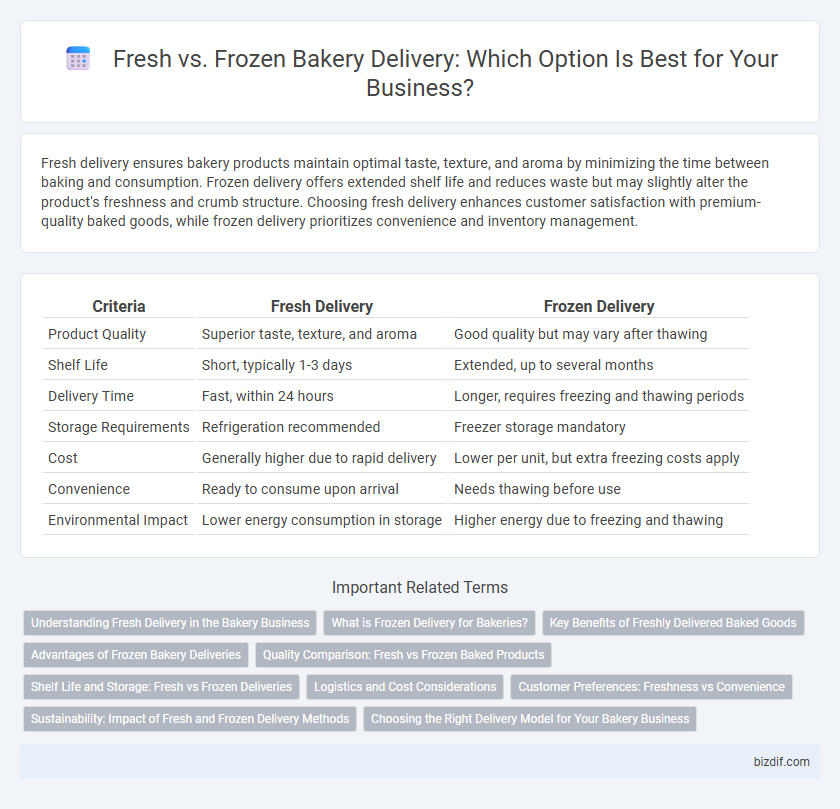Fresh delivery ensures bakery products maintain optimal taste, texture, and aroma by minimizing the time between baking and consumption. Frozen delivery offers extended shelf life and reduces waste but may slightly alter the product's freshness and crumb structure. Choosing fresh delivery enhances customer satisfaction with premium-quality baked goods, while frozen delivery prioritizes convenience and inventory management.
Table of Comparison
| Criteria | Fresh Delivery | Frozen Delivery |
|---|---|---|
| Product Quality | Superior taste, texture, and aroma | Good quality but may vary after thawing |
| Shelf Life | Short, typically 1-3 days | Extended, up to several months |
| Delivery Time | Fast, within 24 hours | Longer, requires freezing and thawing periods |
| Storage Requirements | Refrigeration recommended | Freezer storage mandatory |
| Cost | Generally higher due to rapid delivery | Lower per unit, but extra freezing costs apply |
| Convenience | Ready to consume upon arrival | Needs thawing before use |
| Environmental Impact | Lower energy consumption in storage | Higher energy due to freezing and thawing |
Understanding Fresh Delivery in the Bakery Business
Fresh delivery in the bakery business ensures products retain optimal taste, texture, and nutritional value by minimizing time between baking and consumption. This method enhances customer satisfaction and supports premium pricing by guaranteeing the freshest goods available. Efficient logistics and timely distribution are critical to maintaining product quality during fresh delivery.
What is Frozen Delivery for Bakeries?
Frozen delivery for bakeries involves shipping dough, pastries, or baked goods at subzero temperatures to preserve freshness and extend shelf life without compromising taste or texture. This method allows bakeries to maintain consistent product quality, reduce waste, and streamline inventory management by enabling long-term storage and on-demand baking. Key benefits include minimized spoilage, efficient transportation, and the ability to meet high customer demand quickly.
Key Benefits of Freshly Delivered Baked Goods
Freshly delivered baked goods offer superior taste and texture due to their immediate consumption, preserving the original softness and flavor profile. The nutritional value of ingredients such as yeast, butter, and eggs remains intact without degradation from freezing, enhancing the overall quality. Rapid delivery ensures freshness, reducing the need for preservatives compared to frozen alternatives, meeting customer demand for natural, artisanal bakery products.
Advantages of Frozen Bakery Deliveries
Frozen bakery deliveries extend shelf life significantly, reducing waste and ensuring products maintain optimal freshness until thawed. This method allows for large-scale production efficiency, enabling bakeries to meet high demand without compromising quality. Frozen deliveries also facilitate consistent product texture and flavor, preserving the artisan qualities of baked goods over time.
Quality Comparison: Fresh vs Frozen Baked Products
Fresh delivery ensures baked products maintain optimal texture, flavor, and moisture, preserving the artisan quality that appeals to discerning customers. Frozen delivery can extend shelf life and reduce waste but may compromise the crumb structure and result in a slightly drier or less aromatic product after thawing. For bakeries prioritizing premium quality, fresh delivery remains the preferred method to showcase the product's intended sensory experience.
Shelf Life and Storage: Fresh vs Frozen Deliveries
Fresh bakery deliveries offer a shorter shelf life, typically lasting 1-3 days at room temperature, requiring immediate consumption or refrigeration to maintain quality. Frozen deliveries extend shelf life significantly, preserving product freshness for up to 3 months when stored at consistent freezing temperatures. Proper storage for fresh items includes cool, dry conditions, while frozen products demand airtight packaging to prevent freezer burn and maintain texture.
Logistics and Cost Considerations
Fresh delivery in bakery logistics requires expedited transportation and precise temperature control, often increasing costs due to the need for refrigerated vehicles and faster shipment times. Frozen delivery reduces spoilage risk and allows for bulk shipping, lowering per-unit transportation expenses but necessitates investment in freezer storage and careful thawing processes. Balancing delivery frequency with storage capabilities is crucial for managing operational costs while maintaining product quality in bakery distribution.
Customer Preferences: Freshness vs Convenience
Customer preferences in bakery deliveries often balance freshness and convenience, with many favoring fresh delivery for superior taste and texture that frozen options sometimes lack. Fresh delivery ensures baked goods arrive at peak quality, appealing to those valuing artisanal flavors and soft, moist crumbs. Conversely, frozen delivery attracts customers prioritizing convenience and longer shelf life, enabling flexible consumption without compromising essential freshness.
Sustainability: Impact of Fresh and Frozen Delivery Methods
Fresh delivery minimizes the need for energy-intensive freezing and refrigeration, reducing overall carbon emissions compared to frozen delivery methods. However, frozen delivery allows for longer shelf life and less food waste, contributing positively to sustainability by decreasing the frequency of replenishment trips. Balancing transportation emissions with food preservation is crucial for optimizing the environmental impact of bakery product deliveries.
Choosing the Right Delivery Model for Your Bakery Business
Selecting the right delivery model for your bakery business hinges on product freshness, shelf life, and operational logistics. Fresh delivery ensures optimal taste and texture, appealing to customers valuing quality and immediacy, while frozen delivery extends product lifespan and enables batch production, reducing waste and managing inventory effectively. Assess customer preferences, delivery distances, and storage capabilities to determine whether fresh or frozen delivery aligns best with your bakery's growth and sustainability goals.
Fresh Delivery vs Frozen Delivery Infographic

 bizdif.com
bizdif.com